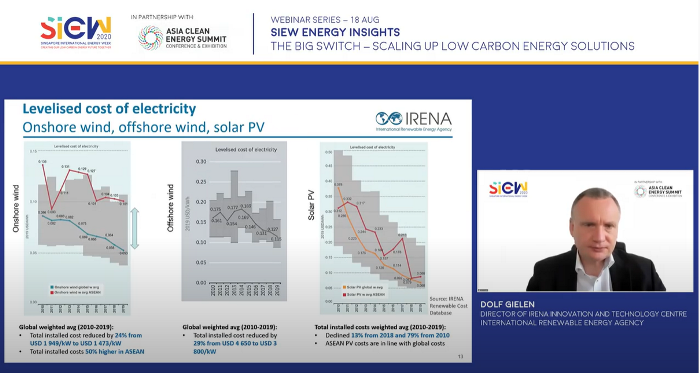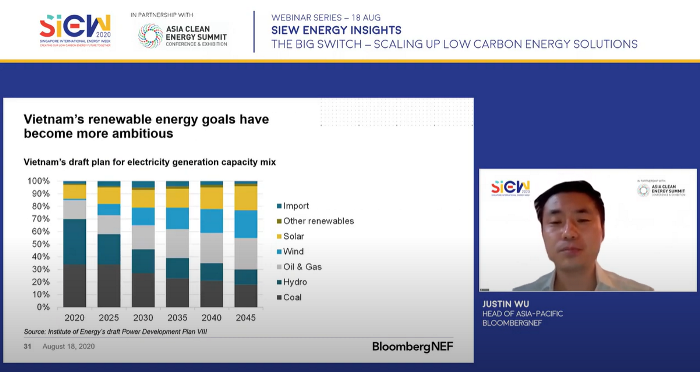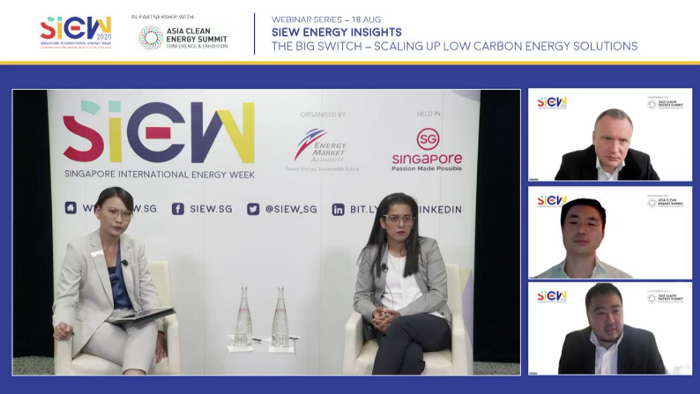Traditional energy sources such as coal and fossil fuels are increasingly making way for cleaner, renewable alternatives worldwide. In ASEAN, the focus is on how the region can accelerate the integration of low carbon energy solutions into the power mix.
In the final edition of the SIEW Energy Insights Webinar Series held on 18 August, co-hosted by SIEW and the Sustainable Energy Association of Singapore (SEAS), the organiser of SIEW partner event Asia Clean Energy Summit, thought leaders discussed the ways ASEAN can respond to drive clean energy adoption.
Dolf Gielen, Director of Innovation and Technology Centre, International Renewable Energy Agency (IRENA), and Justin Wu, Head of Asia-Pacific, BloombergNEF, presented on renewable energy projections in ASEAN. They were later joined by Frank Phuan, Chief Executive Officer and Executive Director, Sunseap Group, and Nirupa Chander, Country Managing Director-Singapore, Hitachi ABB Power Grids, in a panel discussion moderated by Nessa Anwar, Multimedia Journalist, CNBC International.
Bright outlook for renewable energy in ASEAN
Mr Gielen kickstarted the webinar with an outlook for renewables in ASEAN’s energy transition, drawing from IRENA's ongoing research conducted with the ASEAN Centre for Energy (ACE). While renewable energy made up 18% of ASEAN’s primary energy supply in 2017, this figure is expected to more than double over the next three decades.
“With current energy policies in place, the use of renewable energy would reach 39% by 2050. Yet, there is potential that it will become ASEAN’s major source of energy, making up three-quarters of the energy mix,” Mr Gielen said.

What’s driving this uptake? Its economic viability. Mr Gielen noted the cost reductions for solar photovoltaic (PV) systems and offshore and onshore wind energy technology, will continue in the coming years. Its operations are also cheaper than that of existing coal plants. He concluded that cost should be a key consideration in any sustainable energy assessment, as it builds a compelling case for adoption.
Resilient even in the face of a pandemic
Mr Wu from BloombergNEF then discussed the impact of COVID-19 on ASEAN’s progress. While the pandemic did hurt the energy markets, it left a smaller dent on renewables.

“Let’s view the impact of COVID-19 in two stages: what happens right after lockdown, and what happens post-lockdown,” Mr Wu explained. “When lockdown began, there’s a decline in Asia’s power demand. Yet, coal was hit the hardest while renewable energy was generating at higher than usual levels. We expect renewables to continue its recovery in the longer term.”
While oil majors are making significant investment cuts due to falling oil prices, many companies see the move to renewables as a long-term strategic shift that goes beyond the pandemic; more firms are also joining the RE100 commitment, where companies commit to using 100% renewable power.
Collaboration the key piece to the renewable puzzle
During the Interactive Q&A, the panelists fielded questions about the challenges in deploying low carbon energy solutions, commercialisation, and barriers to increasing renewables adoption.
Ms Chander from Hitachi ABB Power Grids believes that the infrastructure is already in place to integrate renewable energy with power grids. The next step is greater interconnectivity between countries to maximise the integration of renewables and optimising power generation and distribution.
“From the technology perspective, it’s possible. The major challenge is getting countries’ policymakers, legality, and financials to come together and iron out the details for commercialisation,” Ms Chander elaborated.

The panelists also touched on the feasibility of deploying offshore renewable solutions to overcome land limitations in ASEAN. Mr Phuan from Sunseap Group shared a recent offshore project and highlighted that the biggest issue lies not in execution but in identifying the location as it required the approval and agreement of 12 different government agencies—a process that took two and a half years.
Looking ahead, collaboration between industry and policymakers remains critical to scaling up clean energy solutions to meet net-zero ambitions. Mr Wu summed up the sentiments of his fellow panelists, saying that “a lot about renewable energy is more possible than we think, if we work together,” echoing the SIEW 2020 theme – Creating Our Low Carbon Energy Future Together.
We hope you have enjoyed the SIEW Energy Insights Webinar series! Register now for SIEW 2020, happening October 26-30, to gain insights from thought leaders on the future of low carbon energy solutions and other key issues.